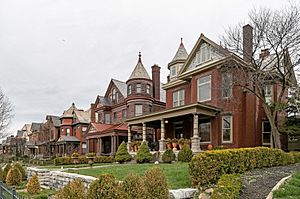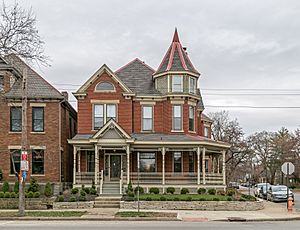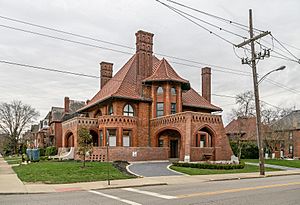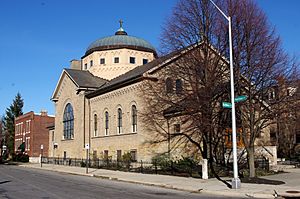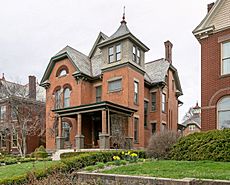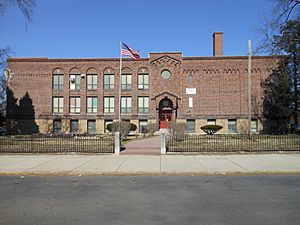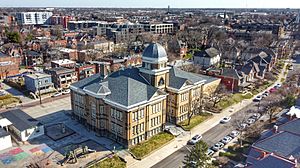Victorian Village facts for kids
Quick facts for kids
Victorian Village
|
|
|---|---|
|
Neighborhood of Columbus
|
|
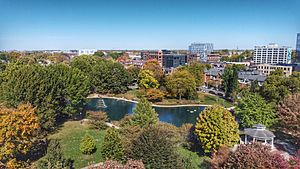
Goodale Park, the focal point of Victorian Village
|
|
| Country | United States |
| State | Ohio |
| County | Franklin |
| City | Columbus |
| ZIP Code |
43201 and 43215
|
| Area code(s) | 614 |
Victorian Village is a cool neighborhood in Columbus, Ohio, located just north and west of the city's downtown area. It's known for its beautiful old homes and lots of trees. This area grew up around 1900 when a streetcar line started running along Neil Avenue.
To keep its special old-fashioned look, the Victorian Village Historic District was created in 1973. Many people think it's one of the best places to live for arts and fun, especially with the lively Short North neighborhood nearby.
Contents
A Look at Victorian Village's Past
The story of Victorian Village began in 1827. A businessman named William "Billy" Neil bought a large piece of farmland north of Downtown Columbus. Over time, he owned a huge area of land. He built a road to his farm, which is now known as Neil Avenue.
After Neil passed away, his family divided the land. The southern parts of his farm became Victorian Village, one of Columbus's first suburbs.
The area grew quickly because of new factories, the creation of Goodale Park (the city's first public park), and streetcar services. In 1879, streetcar lines expanded down Neil Avenue, connecting downtown Columbus to The Ohio State University. This made Neil Avenue a very important road.
Between 1888 and 1902, the land west of Neil Avenue was divided into lots. Most of these lots were set aside for large homes. Electric streetcars started running on High Street in 1888 and Neil Avenue in 1891. This made more people want to live between the university and downtown. By 1920, most of these lots were filled with beautiful homes in styles like Victorian, Italianate, and Queen Anne.
After 1920, cars became more popular than streetcars. People started moving further away to the suburbs. Businesses also moved to be closer to their customers. This caused the neighborhood to decline for a while. Other nearby areas like Flytown, Short North, and Italian Village also faced similar challenges.
Interest in Victorian Village came back in the 1970s. This happened after German Village had a big comeback in the 1960s. The Victorian Village Commission was set up in 1973 to help restore the area. In 1980, Victorian Village was added to the list of National Historic Places.
Where is Victorian Village?
Victorian Village is located north and west of Downtown Columbus. It sits just north of the Arena District and east of the Italian Village. Its southern edge, Goodale Avenue, is very close to the North Market and the Columbus Convention Center. Its northern edge, West Fifth Avenue, is about half a mile from Ohio State University.
It's an older area with many established trees, making it feel green even in the city. Neil Avenue is the main road that runs through Victorian Village. It continues all the way through the Ohio State University campus. The neighborhood shares its eastern border, High Street, with the Short North neighborhood. Harrison Avenue forms its western boundary.
Famous Buildings and Places
Neil Avenue United Methodist Church
This church was built between 1890 and 1914. It was first designed by Yost & Packard and later finished by Stribling and Lum. Since 1996, it has been home to the Ethiopian Orthodox Tewahedo Church.
Goodale Park
Goodale Park is often called the heart of Victorian Village. It's a 32-acre park at the southern tip of the neighborhood. The park is surrounded by Buttles Avenue, Goodale Street, Dennison Avenue, and Park Street.
It's Columbus’s oldest planned park. Lincoln Goodale gave the land to the city in 1851. During the United States Civil War, the park was used to gather Union soldiers in 1861. In 1862, improvements were made, including a fountain and a lake. Later, in 1877, the park even had animals like bears, foxes, and wolves for visitors to see.
The lakes were rebuilt after the Great Depression with money from President Roosevelt's Works Progress Administration. In 1951, the park celebrated its 100th birthday. Today, Goodale Park is famous for hosting ComFest, a big annual festival.
The Circus House
The Circus House was built in 1895 by Peter Sells, who was famous for the Sells Brothers Circus. The architect, Frank Packard, designed this house with ideas from a trip the Sells family took to California. Its unique rooflines, curved windows, and terracotta-tile roof make it look a bit like a circus tent. Packard also designed the carriage house, where the servants lived.
The Sells family filled the house with items from their travels around the world. This made the inside feel very grand and exotic. The home is now privately owned.
41 West Third Avenue
This home was built in 1870. In 1889, Henry Howe wrote his book Historical Collections of Ohio here. In 1910, Dr. Clovis Taylor bought the house and made many changes. He added a new part of the house that featured beautiful mahogany wood. This addition included a bar, a sitting room, a larger entrance, and a famous wraparound porch.
After being used as a funeral home in the 1950s, the house was renovated again in the 1970s. The owner, Larry Schwartzenberger, restored the 14-foot bar and added a 1920s-style soda fountain.
Saint Francis of Assisi Church
This Roman Catholic Church was built in 1896 by Bishop John Ambrose Watterson. In 1907, a school was built next to the church. Seven Dominican nuns taught at the school.
During a city project in the late 1950s, almost 300 houses south of the church were torn down. This caused the church to lose many of its members. The school was updated in 1961 but closed in 1970 because not enough students were enrolled. In 1973, the school building burned down. The church celebrated its 100th birthday in 1996 and is still an important place for many people in Victorian Village.
What Makes Victorian Village Special?
Victorian Village is often named one of Columbus's best neighborhoods. It's a very walkable area, meaning you can easily get around on foot. Many homes here are nationally registered historical landmarks. Some larger homes have been divided into apartments for rent. This mix of housing types adds to the diverse feel of Victorian Village.
Every year, usually in September, the community hosts the Victorian Village Tour of Homes and Gardens. About a dozen houses open their doors for people to explore. The night before, a special "bonus" house is toured as part of a fundraiser for the area. Dinners at local restaurants also help support this event.
Getting Around Victorian Village
Victorian Village has good access to public transportation. It's easy to get around by bus or bike. This means residents don't always need their own cars. The Central Ohio Transit Authority (COTA) runs regular bus services along High Street and Neil Avenue. This makes it simple for people to travel around the neighborhood and beyond.
Schools in the Neighborhood
Victorian Village is part of the Columbus City Schools District. The Hubbard Mastery School is a public school for students from Pre-Kindergarten to 6th grade. It is located on Hubbard Avenue and is the main elementary school for the neighborhood.
Fun Things to Do
Short North Tour of Homes & Gardens
This event usually happens on the third Sunday in September. During this tour, people can visit historic homes in both Victorian Village and the nearby neighborhood, The Short North. The tour typically includes about ten restored historic homes.
Places to Eat and Go Out
You can find many bars and restaurants along North High Street, which forms the eastern edge of Victorian Village. The neighboring area, The Short North, is especially famous for its nightlife and dining options. There are also other fun places to eat and hang out scattered throughout Victorian Village itself.


